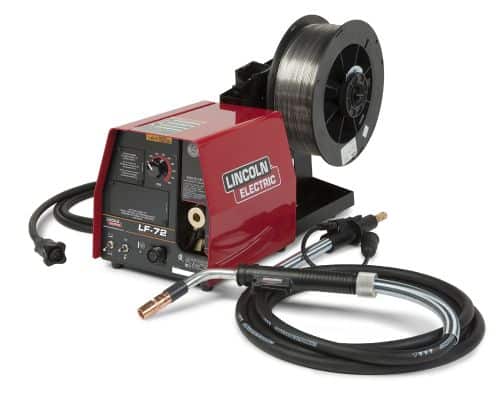In Brief: What Is Flux-Cored Wire?
Flux-cored wire is a consumable, tubular electrode with filler metal on the outside and flux on the inside. It is used in FCAW processes. The two types are self-shielded (FCAW-S) and gas-shielded (FCAW-G). Flux-cored wire excels when welding thick materials and is easy to use. However, the high level of slag production can reduce productivity.
Flux-cored wire is a type of welding electrode wire used in Flux-Cored Arc Welding (FCAW).
It is a tubular electrode type, with the filler metal on the outside and a flux mixture on the inside.
A wide range of flux-cored wires are available, each suitable for a different use case.
This guide will take you through everything you need to know about flux-cored wire.
What Is Flux-Cored Wire?
Flux-cored wire and solid wire are both consumable electrode types because they melt to provide filler metal for the weld.
The main difference between solid wire and flux-cored wire is that solid wire is entirely composed of filler metal, whereas flux-cored wire has filler metal on the outside and flux on the inside.
A Flux Core Wire Feeder

Source: Wikipedia
Flux-cored wires are relatively easy to use, offering high deposition rates and a pleasing weld bead appearance.
They excel when used to weld thick materials, and provide a wealth of mechanical advantages over welds made with solid wire.
There is always a downside, however. Flux-cored wire produces a significant amount of slag which will need to be cleaned after the weld or between passes.
Depending on the processes you have in place, this could reduce productivity if applied inappropriately.
If you want to see an overview of the general FCAW process, check out this video:
There are two main types of flux-cored wire – FCAW-S and FCAW-G.
They are not interchangeable as these two types of electrode wire need to be used with different welding processes.
What is Gas-Shielded Flux-Cored Wire (FCAW-G)
Gas-shielded flux-cored wire requires a gas-shielding setup for your welding process.
FCAW-G functions in much the same way as MIG welding, often using the same equipment barring the wire and sometimes the drive spool.
Drive spools for all flux-cored wires should be knurled to prevent damage from flattening.
CO2 is the gas most commonly required for FCAW-G electrode wire, though some wire classifications require a CO2 – Argon blend.
You can tell which shielding gas is required by checking the classification. The “C” in the classification code E70T-1C H8 means that this type of wire requires pure CO2.
The “M” in the classification code E71T-1M means that this type of wire requires a CO2 – Argon blend.
Gas-shielded flux-cored wire boasts higher deposition rates and 75-85% efficiency compared to 60% efficiency for FCAW-S wire.
You will typically get a better quality weld from FCAW-G over FCAW-S.
However, the gas-shielding means that FCAW-G is most useful in a shop setting. On a job site, the wind may interfere with the gas-shielding, making FCAW-S the better option in these circumstances.
What is Self-Shielded Flux-Cored Wire (FCAW-S)
Self-shielded flux-cored wire does not require a shielding gas as it can produce its own.
In the process of welding, the flux mixture reacts to form its own cloud of shielding gas to protect the welding pool from contaminants.
Self-shielded flux-cored wire has the distinct advantage of not requiring a gas-shielding setup.
As a result, FCAW-S is a far more portable and versatile process as it reduces the equipment requirements for the job.
However, the gases produced by the flux mixture increase spatter and decrease general weldability when compared with the flux mixture found in FCAW-G wire.
This results in a lower quality weld.
Summary
We hope this guide has helped you to understand the construction and function of flux-cored wire. It pays to know your options when it comes to welding equipment and consumables.
If you have any questions or comments about this guide or flux-cored wire in general, please feel free to leave them in the comments section below.


